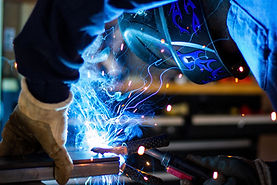
Sanitary Design
Discover Sanitary Design Excellence. Our Service Transforms Stainless Steel Workspaces, Equipment, and Structures into Pristine Havens of Cleanliness. Your Commitment to Quality and Hygiene Starts Here!
Sanitary design in steel metal fabrication refers to the process of designing and manufacturing steel components, equipment, or structures with a focus on maintaining strict hygiene, cleanliness, and sanitation standards. This concept is particularly important in industries where contamination control and product safety are paramount, such as food and beverage processing, pharmaceuticals, biotechnology, and healthcare.
Here are key aspects of sanitary design in steel metal fabrication:
1. Material Selection: Choosing the right type of stainless steel is crucial. Stainless steel is preferred for its corrosion resistance, durability, and ease of cleaning. Specific grades of stainless steel, such as 304 or 316, may be selected based on the application's exposure to corrosive substances or environmental conditions.
2. Smooth Surfaces: Sanitary design emphasizes the use of smooth, non-porous surfaces that are easy to clean and prevent the accumulation of dirt, debris, or microorganisms. This includes using materials with minimal surface imperfections and welds that are ground smooth.
3. Seamless Joints: Where steel components are joined, sanitary design minimizes crevices, gaps, or dead spaces where contaminants can accumulate. Welds are designed to be continuous and flush, without pits or cracks.
4. Curved and Sloped Surfaces: Curved and sloped surfaces are preferred over sharp angles or corners, as they reduce the likelihood of product buildup and facilitate efficient cleaning and drainage.
5. Hygienic Gaskets and Seals: Where seals are necessary, the use of food-grade, hygienic gaskets and seals is common to prevent product or contaminant ingress.
6. Easy Disassembly and Cleaning: Sanitary steel equipment or structures are designed for easy disassembly and reassembly for thorough cleaning and sanitation. Quick-release clamps, fittings, and fasteners may be employed for this purpose.
7. Surface Finish: The surface finish of steel components may be specified to meet specific hygiene standards. Electropolishing or mechanical polishing can achieve the desired smoothness and cleanliness.
8. Drainage and Ventilation: Proper drainage channels and ventilation are incorporated into the design to prevent the buildup of moisture or condensation, which can promote bacterial growth.
9. Access for Inspection: Sanitary designs include access points for regular inspection and maintenance to ensure that no hidden contamination sources exist.
10. Compliance with Regulations: Manufacturers adhering to sanitary design principles ensure that their products comply with relevant industry regulations and standards, such as those set by the Food and Drug Administration (FDA) or the European Hygienic Engineering and Design Group (EHEDG).
Sanitary design in steel metal fabrication is essential for industries where maintaining product purity, safety, and quality is critical. It helps prevent product contamination, ensures compliance with regulatory requirements, and promotes efficient and effective cleaning and sanitation procedures. Whether it's stainless steel tanks, conveyor systems, processing equipment, or facility infrastructure, the principles of sanitary design are essential for businesses in these highly regulated sectors.



![[Original size] 2018 (1).png](https://static.wixstatic.com/media/ab7d8f_198b2590ecc341c3bbf2b2625303f777~mv2.png/v1/fill/w_253,h_103,al_c,q_85,usm_0.66_1.00_0.01,enc_avif,quality_auto/%5BOriginal%20size%5D%202018%20(1).png)